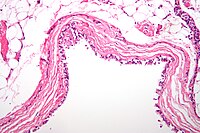
Photo from wikipedia
Thyroglossal duct cyst (TGDC) is the most common congenital cyst in the neck and is removed by the Sistrunk procedure. This surgery involves a horizontal skin incision over the cyst… Click to show full abstract
Thyroglossal duct cyst (TGDC) is the most common congenital cyst in the neck and is removed by the Sistrunk procedure. This surgery involves a horizontal skin incision over the cyst that may leave a noticeable scar on the front of the neck. Therefore, this study examined the clinical outcomes and cosmetic benefits of the Sistrunk procedure by an incision in the submental area that is not easily visible from the front. This observational study was performed on 152 patients who underwent the Sistrunk procedure by a submental approach to remove TGDC at a university medical center. Intraoperative findings, postoperative complications, subjective pain levels, and satisfaction with incision scars and neck and facial deformities, and recurrence were prospectively evaluated. The length of the submental incision was about 3 cm and the median total operation time was 36 min. Postoperative complications were minimal. Hematoma occurred in two cases (1.3%), surgical site infection in 1 case (0.7%), and dysphagia for more than 1 week occurred in 1 case (0.7%). On a 0–10 visual analogue scale, the pain had a median value of 2 on the first day after surgery, and satisfaction with incision scars and neck and facial deformities showed median values of 8 and 10 at 6 months after surgery, respectively. Recurrence occurred in one patient (0.7%) during the median follow-up period of 68 months. The submental approach for TGDC excision may be a reliable new surgical method that is safe and has cosmetic advantages. This observational study evaluated the clinical outcomes and cosmetic benefits of the Sistrunk procedure by a submental incision for thyroglossal duct cyst in 152 patients. The surgical procedure showed no increased operation time, no need for wide flap elevation, easy suprahyoid dissection, and an invisible scar in a natural position of the neck.
Journal Title: World Journal of Surgery
Year Published: 2022
Link to full text (if available)
Share on Social Media: Sign Up to like & get
recommendations!